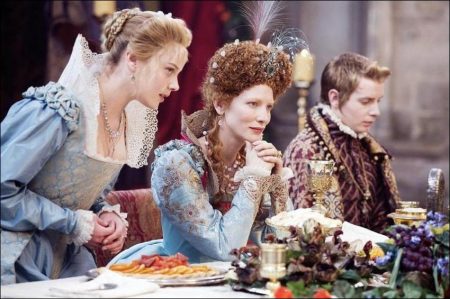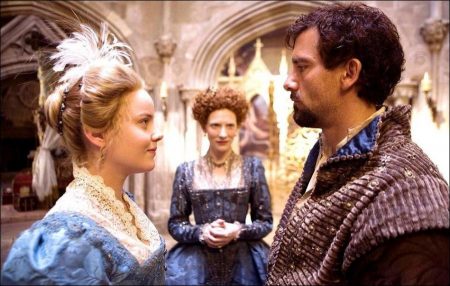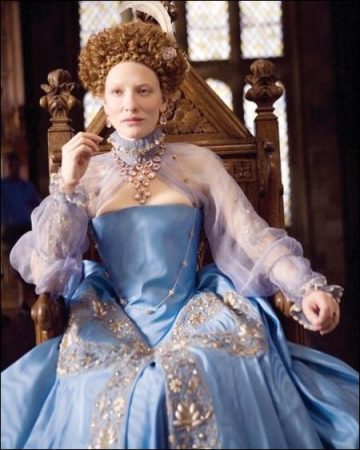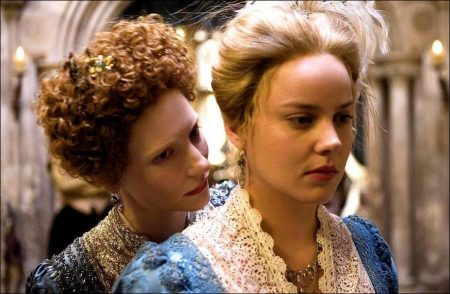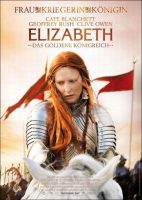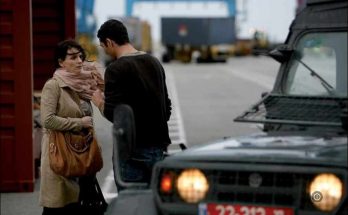Tagline: Woman, Warrior, Queen.
Elizabeth: The Golden Age movie storyline. Academy Award winner Cate Blanchett returns to her star-making role from Working Title Films’ seven-time Oscar-nominated 1998 film Elizabeth. She is reunited with her collaborators from the worldwide crossover hit—Academy Award winner Geoffrey Rush and Golden Globe- and BAFTA-nominated director Shekhar Kapur—in this gripping historical drama laced with treachery and romance: Elizabeth: The Golden Age. Signing on to the new epic is Golden Globe winner and Oscar nominee Clive Owen (Children of Men) as Sir Walter Raleigh, a dashing seafarer in whom Elizabeth finds newfound temptation.
It is 1585 and, having reigned over England for nearly three decades, Queen Elizabeth I (Blanchett) continues to face bloodlust for her throne and the lingering threat of familial betrayal. A channel away, a destructive wind of fundamentalist Catholicism blows across 16th century Europe, with Spain’s Philip II (Jordi Molla of Sultanes del Sur), its figurehead.
Backed by the Church in Rome and armed with the Inquisition, Philip—with his powerful army and sea-dominating armada—presents an imminent threat to Queen and Country…the dark and pious king is determined to wrest the Protestant “heretic” from the throne and restore England to the glory that is the Roman Catholic Church.
Preparing to go to war to defend her empire, Elizabeth also struggles to balance ancient royal duties with an unexpected vulnerability in her love for Raleigh—despite his status as a commoner—who remains forbidden for a Queen sworn body and soul to her country. Unable and unwilling to pursue her passion, Elizabeth encourages her favored lady-in-waiting, Bess (Abbie Cornish of the upcoming Stop Loss), to befriend Raleigh and keep him near.
But such a strategy places Elizabeth at the center of their courtship, where she has no choice but to observe their growing intimacy. In the dashing and adventurous Raleigh, she sees not only an intellectual and spirited equal, but also a clarion of lands beyond, the unexplored globe, infinite…freedom. By electing Bess to take her place, she is ultimately forced to make the anguishing choice between being a woman and being a Queen.
And as she charts her course abroad, Elizabeth’s trusted advisor, Sir Francis Walsingham (Rush), continues his masterful puppetry of her court at home—and her campaign to solidify absolute power. Through an intricate spy network, Walsingham uncovers an assassination plot that could topple the throne. But as he unmasks traitors that may include Elizabeth’s own cousin Mary Stuart (double Oscar nominee Samantha Morton of In America), he unknowingly sets England on a course of destruction.
About the Production
“I am called the Virgin Queen. Unmarried, I have no Master. Childless, I am Mother to my people. God give me strength to bear this mighty burden.” — Queen Elizabeth I
Released in 1998, the bold and visceral Elizabeth started out as a well-pedigreed art-house hit, and—buoyed by a bravura turn by then star-on-the-rise Cate Blanchett, an accomplished cast, superlative storytelling and sensual production values—it grew into an international phenomenon.
Elizabeth was nominated for a total of seven Oscars (including Best Picture and Best Actress for Blanchett, with makeup designer Jenny Shircore winning), 11 BAFTAs (winning six) and three Golden Globes (with Blanchett walking away with a statue). The magic seemed to lay in the filmmakers’ vision of a great historical epic told in an iconoclastic and contemporary way—an approach rendering it accessible to a modern audience—and in Shekhar Kapur’s direction (a reinvention of period drama through a decidedly Eastern sensibility).
During production of Elizabeth, the filmmakers discussed the idea of telling the story of Elizabeth I—from the young girl to the Queen who ruled nearly 45 years—in a trilogy of films. Says producer Tim Bevan, “Elizabeth the First’s entire reign could not be told effectively in one film—it was so long and so much happened during it, and she encountered so many extraordinary people.”
Encouraged by the global success of Elizabeth, the discussions continued over the intervening years, and approximately five years after the completion of Elizabeth, the team felt the time was right to commission writers Michael Hirst (who penned the first film) and William Nicholson to begin work on the screenplay that would become Elizabeth: The Golden Age.
In Elizabeth, the story focused on the early (and somewhat uncertain) years of the fledgling ruler’s reign. The young queen faced an uphill struggle to hold on to her throne, outfoxing conspirators and deceivers at every turn. Never certain which of her court and advisers could be trusted, the headstrong and savvy Elizabeth emerged at the end of the film as a Queen, firmly in charge of her destiny…
Elizabeth: The Golden Age commences a decade after the period covered in Elizabeth and examines the glorious middle years of her rule. On a political level, the film explores Elizabeth’s conflict with Philip II of Spain, who—as the ruler of his own Catholic empire with the considerable backing of the Church in Rome, not to mention the might of the ruthless Inquisition—was regarded as the most powerful man in the world.
Religiously devout, he had sworn to blanket the world in Catholicism, whatever the cost. When Elizabeth succeeded to the throne as a Protestant in 1558, nearly half of England’s population remained Catholic, but—in one of many characteristically skillful moves—she chose to view her people as her subjects, dogma notwithstanding. She reasoned they loved her before they were either Protestant or Catholic. (“I have no wish to open windows into men’s souls,” she explained… basically meaning “think what you like, but act as my Protestant subjects.” Throughout her reign, Elizabeth I proved extremely tolerant to her Catholic subjects and constantly protected them against virulent protests and cries to persecute, many of which arose from the floor of her own Parliament.) The new film sets about to examine the notion of religious tolerance set against fundamentalism—a timely subject that resonates today.
Director Kapur believes that “by delving into history, you wind up telling a contemporary story about ourselves. Why make a film today that is not relevant to today’s times? Why make a film that’s not relevant to today’s individual, political or psychological attitudes? Elizabeth: The Golden Age is about Cate Blanchett, who is interpreting Elizabeth for modern times. It’s about the conflict between fundamentalism and tolerance, the search for the self, divinity. It’s about mortality and immortality. It’s all things we deal with in our personal lives every day.”
On a more personal level, The Golden Age looks beyond the political conflicts to deal with Elizabeth as a woman, inwardly conflicted while on her voyage from mortality to divinity—due in large part to one of the greatest romantic involvements in her life, the larger-than-life adventurer and soldier Sir Walter Raleigh. At the heart of this is the exploration of a triangular relationship among Elizabeth, Raleigh and her favorite ladyin-waiting, Bess Throckmorton.
The Queen plays a costly game of chess with the dashing Raleigh and the beautiful Bess…eventually experiencing a vicarious relationship with Raleigh (through the young Throckmorton) that she denies herself. In some ways, Elizabeth hopes to keep Raleigh’s mind and spirit to herself, while giving him her body in the form of Bess. In that costly gamble, she ends up losing the game and, ultimately, control of Raleigh’s heart.
Marking their third collaboration together (he produced both Bridget Jones films), Jonathan Cavendish produces the film with Working Title Films’ Tim Bevan and Eric Fellner. Cavendish states, “The opportunity to work with Shekhar was an attractive one, and it turned out to be an enormously stimulating experience. He’s very collaborative.
He’s constantly bringing in new ideas, rejecting old ones, and has the bravery and the imagination to keep questioning things. He operates on metaphorical and mythical levels, always keeping two or three ideas going below the surface, so the scene appears to be about one thing, but is often much more about something else altogether.”
With a script in the works, the filmmakers set about reuniting the creative team whose work on Elizabeth had made it the subject of such acclaim—specifically director of photography Remi Adefarasin, costume designer Alexandra Byrne and hair and makeup designer Jenny Shircore, all Academy Award-nominated, with Shircore winning hers. Also returning to the project would be editor Jill Bilcock, who received a BAFTA nomination for her editing of Elizabeth. Finally, the filmmakers signed production designer Guy Hendrix Dyas, whose bold vision is evident in such films as X2 and Superman Returns.
The Return of the Queen
As the story is about Elizabeth, it was, of course, essential to secure Cate Blanchett in the part. “Without Cate as Elizabeth, Elizabeth: The Golden Age could not have been made,” Kapur simply states.
Interestingly enough, the Oscar winner and prolific Blanchett was not immediately attracted to the idea of returning to the role. Kapur and Rush campaigned Blanchett over dinner, and it was only later that she agreed to portray the ruler once again. Blanchett explains, “It helped, however, when I played Hedda Gabler in a production in Sydney, and then again 18 months later in New York. I had a sense that through returning to a role, you can delve deeper into it.
“I’ve learned much more about filmmaking since Elizabeth,” the actor continues. “That said, it is a tricky role and there are times when I thought I’ve got it all wrong and I wanted to start again. I think that’s the testament to a really powerful, complex character—there are an infinite number of ways you can approach her…and because film is temporal, this is the way we chose to do it at the time. Elizabeth is a character who continues to fascinate people; it’s why so many versions of her life have been told. What is revealed about her depends on where you shine the light.”
“For Cate,” Kapur acknowledges, “this is a far more challenging part, where she is much more active than reactive—Elizabeth is now far more complex. Cate has given a performance that maintains the vulnerability she expressed in Elizabeth, but now, it is underneath the surface of this much stronger woman.”
The concept of appearances—literally, that Elizabeth I lived and reigned at the center of a theatrical stage—is one of the things that intrigued Blanchett: “Elizabeth explored denial, what one had to extricate from oneself in order to lead. She made herself into an icon, an image that she polished and honed for political ends…and I surmise for emotional protection. The journey of The Golden Age, in many ways, is about acceptance. What I have tried to do in this film is to create a sense of a hollow woman—without a companion, a husband, a child—searching for what replaces that void.
“Elizabeth had a vigilant sense of self-control,” Blanchett continues. “She was very controlling about her image. What the film deals with, among other themes, is that as she began to age, her availability to be married and form alliances with other countries—a very powerful weapon—was ebbing away. Her physical attractiveness and ability to bear children was questioned. It deals with the political pressure, as well as pressure from within. Things that she’s kept suppressed for so long come flooding to the surface, especially in the relationship she forms with Raleigh.”
For Blanchett, her relationship with Raleigh proved to be the most motivating aspect of stepping back into the role. As the script began to evolve, an exploration of a love triangle that develops among Elizabeth, Raleigh and Bess was brought to the fore.
Another draw for the leading lady was the opportunity to re-team with director Kapur. “We connect,” she shares. “We always understand where one another is coming from. He comes up with ways of entering a scene which are completely unique, but at the same time, he is intensely collaborative and genuinely loves what actors bring to the scene. He will reshape a scene around a moment an actor brings, if it feels right.”
Supplies Kapur: “Cate has a remarkable combination of talent, control, understanding, intellect and emotion. These qualities—along with incredible discipline—allow her to seamlessly shift between different sides of the character she plays. I’ve never seen her when she’s not at work on the role. She works all the time. If she has two minutes off, she’ll be listening to her lines on tape, and thinking about them. She’s unbeatable.”
Adds producer Tim Bevan: “Cate realized in the first movie that she was talking to contemporary women; what she’s done in this film is explore the price of having it all. For Elizabeth, it’s career, the price of being omnipotent and the price of being a woman in a man’s world. I think that will speak directly to all women.”
Geoffrey Rush etched a memorable portrait of Elizabeth’s great adviser Walsingham in Elizabeth, and re-signed to the role even before the acceptance of their Queen. The Oscar winner was more than eager to again plumb the depths of such a powerful man, whom some considered as slippery as he was savvy.
Rush comments, “Walsingham was the great spymaster. He moved his way into a very powerful position in Elizabeth’s court and, by the 1580s, he was masterminding one of the greatest espionage networks throughout Europe. He was an intellectual of that age and was the person that created the powerful notion of the ruler being a divine figure. He was a person of great discipline and control, as was his Queen.”
In The Golden Age, this control is threatened when Walsingham uncovers his brother’s betrayal. Though not historically accurate, the plot point is included for a specific reason, as Rush explains, “Shekhar was interested in exploring what happens when powerful public figures are eaten away by their personal dilemmas…and through his brother’s involvement in a plot, we see Walsingham’s uncertainty and vulnerability exposed.”
The opportunity to take the character further than had been explored in Elizabeth was a determining factor in Rush’s decision to return to the role. Walsingham had served as a mentor to the young Elizabeth, guiding the uncertain woman into the responsibilities of leadership as dictated by a staunch and philosophical standpoint. Now, decades later, the great adviser finds himself reduced to a more statesmanlike role, with much of his political clout and influence over Elizabeth having waned.
Offers producer Cavendish, “Walsingham’s journey in this film is extremely moving. His powers are failing him. He’s not quite on top of his game any longer. And Geoffrey lends a gravitas to the characterization which is quite astonishing to watch.”
As with Blanchett, Rush was persuaded to return by having Kapur in the director’s chair again: “Shekhar is one of the most adventurous and aesthetic filmmakers with whom I have worked,” the actor notes. “When he talks to the actors or any one of the crew, it is always in very appealing images rather than instructions. He communicates very imaginatively and during the shooting of a film, imagination is a great thing to keep alive. He does it with great humor and great playfulness—and sometimes very refreshing seriousness—about the deeper aspects of our characters’ lives. It gives you something more to play with, something that’s not bound up with the minutiae of psychological motivations and historical accuracy. These events are so complicated that you have to find a dramatic form—in the end, the story you tell has to capture the primal elements of what’s going on between these people, these nations.”
Into the court of this accomplished ruler and her fading lion comes the bold explorer Sir Walter Raleigh—a colorful figure who conjures almost as many myths as Elizabeth I does. Filmmakers were intent upon casting an actor with the abilities and the physical attributes to bring the hero alive.
Enter Clive Owen, whose commanding, primal and edgy performance in Closer netted him an Oscar nomination and mature performance in 2006’s Children of Men was roundly lauded. As Sir Walter Raleigh, an ambitious seaman who manages to inveigle his way into the court and into the Queen’s heart, Owen effortlessly captures the spirit of the role. Commends Bevan: “Into the mix came Clive Owen, who read the part of Raleigh and decided that one was for him— which unconditionally, was fantastic.”
Says the director: “Clive is an amazing actor and has the personality and the face I totally believe as Raleigh. He’s undeniably credible as the free electron that comes in and creates chaos.”
For Owen, it was the jumble of Old World and contemporary qualities that made playing the character so enjoyable. He offers, “Raleigh had a breath of fresh air about him, a freedom, an energy. He was a complicated mixture—attractive and very well educated, but also outspoken and incredibly arrogant at the same time. His cavalier attitude impressed as many as it offended.”
Blanchett describes her character’s affection for Raleigh not so much as love, but as a combination of love and envy: “It isn’t the youthful ebullience that she experienced with Dudley in Elizabeth. It is a more wistful vicariousness, that ‘If only I could be him.’
I think it is possible to fall in love with someone that you want to emulate, and somehow to be with them is to live through them, to be inside them, and to see the world through their eyes—to live another life, be another person. As cultured, well-read, eloquent and intelligent as Elizabeth was, she had never left the shores of England, and in Raleigh, she saw a hero who had discovered a new world and had literally traveled to where the maps end.”
About the relationship the film explores between Elizabeth and Raleigh, Owen explains, “Raleigh may have been many things, not the least of which was ambitious. His priority at first is to secure funding for another expedition, and his plan is to win favor with the Queen, so that she would fund his trip. But he is unexpectedly impressed by her and attracted to her. He had an honesty about him, which set him apart from most people at court, and she probably found that very attractive.”
Too, Owen was quite a fan of the first film. “The most striking thing about Elizabeth was Shekhar’s perspective, where he chose to put the camera,” the actor offers. “The events felt epic, bold, hugely important. He’s applying the same tools here. As actors, we’re not restricted by his pre-conceived ideas. If he sees actors working in a particular way, he’ll work to develop that. It’s a very inspiring and creative way of working.”
The weight of playing an historical figure also struck Owen, but he adopted a philosophy that dovetailed with the filmmakers’ views on their subjects: “There is an element with any film that explores a real character—at a certain point, the film has to take over from history, and it’s my responsibility to play Raleigh as the filmmakers see his function.”
The third corner of the triangle, Elizabeth’s young and attractive lady-in-waiting, Elizabeth “Bess” Throckmorton, was a pivotal role for filmmakers to fill. Jonathan Cavendish explains, “We wanted someone who expressed freshness, youth and energy, somebody upon whom Elizabeth could reflect as being a younger version of herself. We wanted someone who wasn’t widely known, but who also had the acting ability and charisma to hold her own opposite Cate.” Abbie Cornish fulfilled those criteria, with her eye-opening performance in the Australian coming-of-age film Somersault going a long way toward attesting to considerable talent.
Her co-star Geoffrey Rush, with whom she worked in the recent Australian release Candy, states, “The camera absolutely adores her. There’s no training, no technical background, it’s just a pure innate artistry. She’s one of those great talents that constantly alerts one to what’s going on underneath.”
The 25-year-old Cornish relished the prospect of playing a character from a world that was completely unknown to her, opposite an impressive cast. She states, “There is something intriguing about Bess, in that she carries both light and dark. Shekhar has an ability to dive in and explore something endlessly and without limits, without any boundaries.”
The sexual and romantic politics were as intriguing to Blanchett, who supplies, “It became interesting for me to play the notion of a Queen who had made a choice that she would use her virginity, her status as a single Queen, as a political tool. Given her mother, Anne Boleyn’s, fate—and also the fate of many women at that time in childbirth—marriage and all that it then entailed had little to recommend for Elizabeth I.
What would she gain? She dispatches Bess like Prospero does Ariel to have an experience that she can’t have. And while she’s in control of the chess game between Bess and Raleigh, of their moving towards one another, there’s pleasure in it. Of course, the rules change when they fall in love and Elizabeth realizes she no longer has control of the game.”
There are bigger games on the horizon for the Protestant Queen—literally just across the sea—in the form of the Catholic ruler King Philip II of Spain. The role was filled by Spanish star Jordi Molla, who surprised and delighted filmmakers with his unexpected interpretation of the role. Says Molla: “Shekhar described Philip like a bat—always praying, in the darkness—yet, at the same time, the most powerful man in the world. I liked the idea of expanding that notion, the thought that he was this powerful man, but he was also a man with a huge complex. I wanted to play him with a very weak voice and an unusual gait…peculiarities that could have made him the object of ridicule and provide a reason for his complex.”
Another Mary who figured into the history of England was Mary Queen of Scots, Elizabeth’s cousin, the daughter of James V of Scotland and Mary of Guise, remembered for her beauty, misfortune and political ineptitude. Under the laws of English succession, Mary was next in line to the throne after Elizabeth I—and in the eyes of many Catholics, she was the rightful queen. This sentiment led to Mary’s imprisonment under Elizabeth for 19 years.
Determined not to spill the blood of another queen, Elizabeth demurred each time the idea of Mary’s execution was brought to her by political allies. Eventually, Mary’s continual implication in plots to assassinate Elizabeth and place herself on the throne proved her undoing (the final one, the Babington Plot, some consider a conspiracy launched by Walsingham—which The Golden Age explores). When Mary was executed for treason at Fotheringhay Castle in 1587, Elizabeth was 44 years old. And it was Mary’s execution that fueled Philip’s launching of the Armada against Elizabeth and her country.
Double Oscar nominee Samantha Morton (for Woody Allen’s Sweet and Lowdown and for her wrenching performance as an Irish immigrant in the drama In America) welcomed the chance to embody such a legendary and controversial woman.
Morton says, “I found Mary a fascinating character, and I found Shekhar’s attitude towards her very exciting, refreshing and very daring—not with the intention of courting controversy, but to capture her essence. He approaches every character in a fresh and original way. He chooses not to bring any baggage in regards to what has already been said or done, and while he has a healthy respect for the subject matter, he gives an actor complete artistic freedom within that.”
Of his choices, director Kapur reflects, “I wouldn’t say we’ve taken liberty with history, because all history is interpretation. Say you have a conversation with me today and tomorrow, when you tell somebody about that conversation—one day old—you’d be giving your interpretation of it. So 400 years later, interpretations differ. Remember that over these years, history was written by people who took them down for the ruling courts—they wrote the history for the ruler of the time, and if that ruler didn’t like it, then they’d have the writer’s head chopped off. So history had to be interpreted at that time in favor of the ruler. So what I do, today, here and now, is simply tell a story, and I’m attracted to this story for modern reasons…for reasons that resonate within myself.”
Elizabeth: The Golden Age (2007)
Directed by: Shekhar Kapur
Starring: Cate Blanchett, Clive Owen, Geoffrey Rush, Samantha Morton, Abbie Cornish, Jordi Molla, Eddie Redmayne, Stuart McLoughlin, Rosalind Halstead, Adrian Scarborough
Screenplay by: William Nicholson, Michael Hirst
Production Design by: Guy Dyas
Cinematography by: Remi Adefarasin
Costume Design by: Alexandra Byrne
Set Decoration by: Richard Roberts
Art Direction by: David Allday, Christian Huband, Jason Knox-Johnston, Phil Sims, Andy Thomson, Frank Walsh
Music by: A. R. Rahman
MPAA Rating: PG-13 for violence, some sexuality and nudity.
Distributed by: Universal Pictures
Release Date: October 12, 2007
Views: 76
